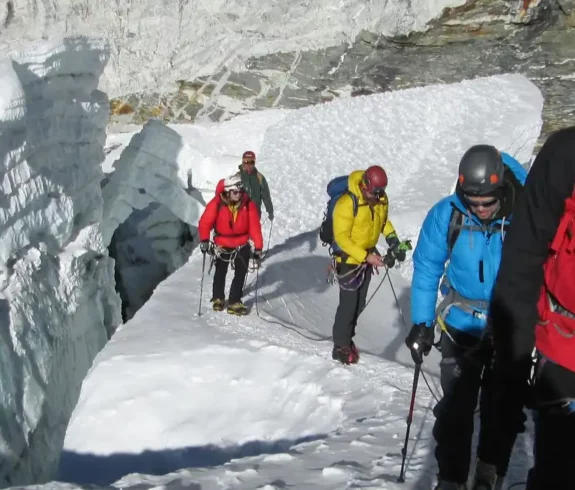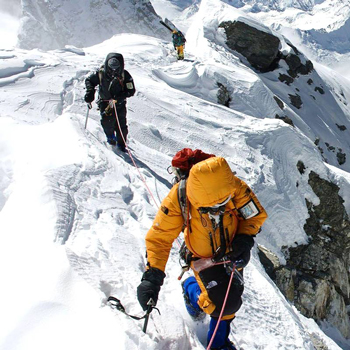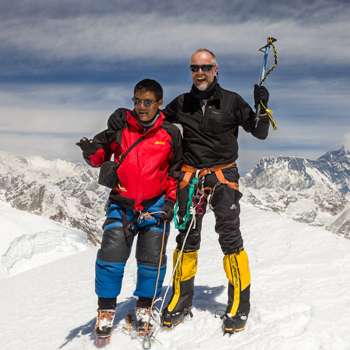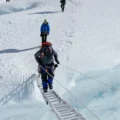The Everest region of Nepal features a mountain called Imja Tse or Island Peak, which is 6189 meters high. Against the towering Himalayan ranges, this mountain is an excellent first-time high-altitude climbing experience. The “Island Peak Climbing Itinerary” combines trekking and mountaineering, creating a complete adventure that appeals to novice and seasoned climbers. Many choose this peak for its thrilling climb, accessibility, and suitability as a training ground for more challenging Himalayan expeditions.
Climbing Island Peak is not only a trek to reach the destination, but it also offers better engagement. Here are the top seven reasons as to why such a climb has become an addictive sport to so many adventure lovers:
- Panoramic Mountain Views: The climbers reach the mountain top and get eye-catching views of the nearby peak, Mount Everest, the highest peak in the world.
- Scenic Views of Lhotse and Makalu: Apart from Everest, this peak also provides fine sights of two other beauties, Lhotse and Makalu, which are towering mountain ranges and beautiful.
- Diverse Climbing Experience: The climb combines trekking, rock climbing, and walking on a snow surface, a joy for well-balanced climbers.
- Crossing the Khumbu Glacier: The route takes climbers across the Khumbu Glacier, highlighting the powerful and ever-changing landscape of the Himalayas.
- Insight into Tibetan Culture: The trek to Island Peak introduces climbers to the rich Tibetan culture, with visits to local monasteries and encounters with the friendly Sherpa community.
- Unique Flora and Wildlife: On the way, trekkers encounter rich ecosystems with unique wildlife and colorful vegetation, which makes the trekking more fascinating.
- Preparation for Higher Himalayan Peaks: Climbing Island Peak and getting to the top is also the best epitome for those who wish to climb more technically challenging peaks.
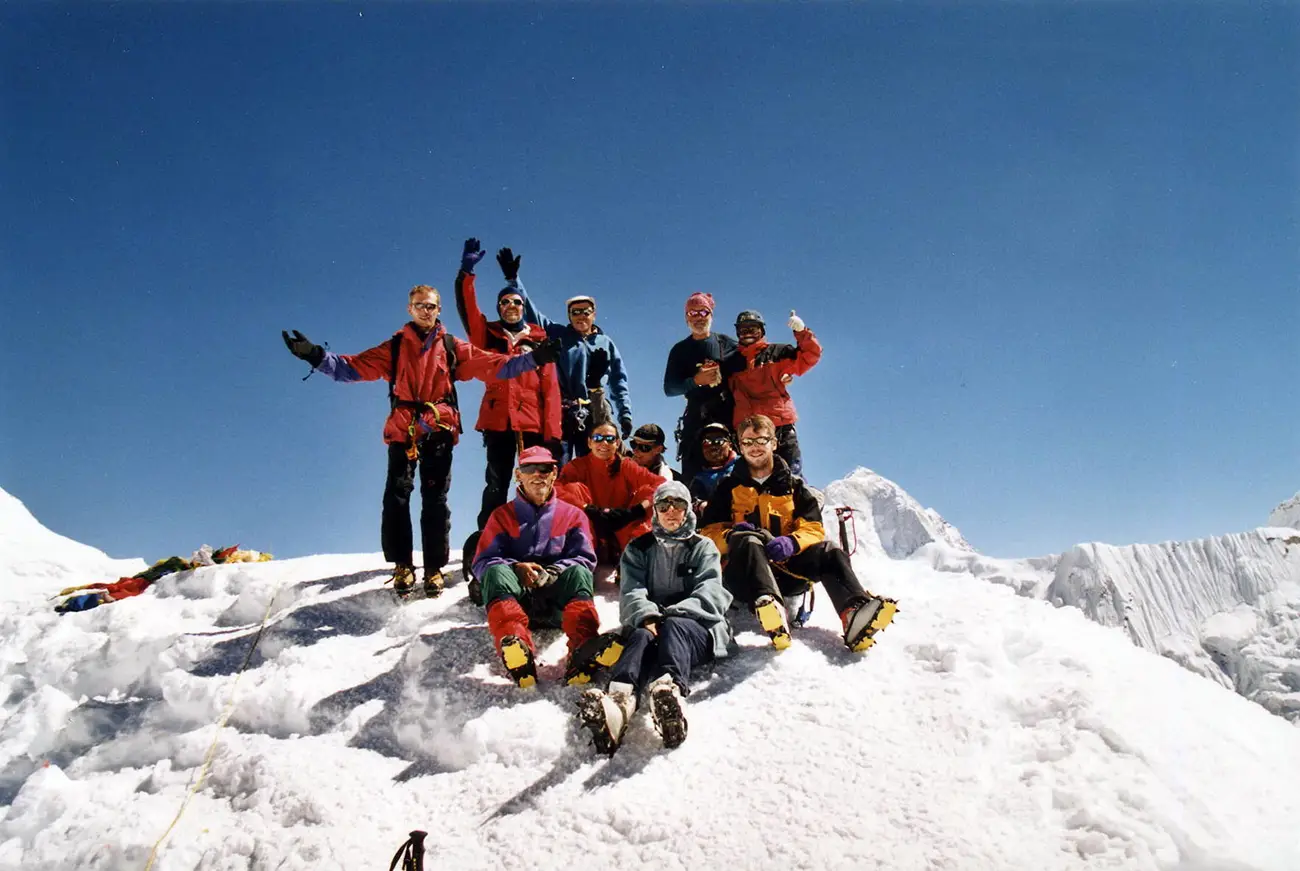
Why Choose Island Peak?
Island Peak, known locally as Imja Tse, has become a top choice for climbers seeking an introduction to high-altitude mountaineering. The “Island Peak Climbing Itinerary” attracts beginners and seasoned adventurers because it offers the perfect blend of accessibility, thrill, and preparation for more challenging climbs. Here’s why so many climbers prefer Island Peak:
- Ideal for Novice Climbers: Island Peak is the best option for anyone with no experience in climbing at high altitudes. The incline is gentle, there are less than three technical sections, and routes are well established, making it an excellent place to begin. Because the instructors are skilled, novice climbers will be taught the most important aspects of mountaineering, such as how to travel on glaciers, perform rope work, and use an ice axe.
- Accessible Yet Thrilling Experience: The climb is easy and exciting. The climbers first set out on a trek through the renowned Everest Region, studded with Sherpa villages and green plantations. The difficulty levels increase with elevation; hence, the level style, which consists of walking trails, dirt terrain, and ice, is captivating but not discouraging elementary climbers.
- Preparation for Higher Peaks: Most climbers view the Island Peak Climbing Itinerary as an introduction to more complex and sophisticated climbs like Ama Dablam, Lobuche, or Mount Everest.
- The climb enables the climbers to practice working with the climbing equipment, familiarize themselves with conditions experienced at high altitudes, and get psyching up for the next climbs. It is the preparatory stage for conquering other higher and more technical mountains.
- Stunning Himalayan Scenery: At the summit of Island Peak, the views are almost as good as those experienced from higher summits. While at the peak, climbers can spot Lhotse, Makalu, Baruntse, and Ama Dablam. These beautiful sceneries contribute to the overall pleasure and accomplishment after getting on top of the peak. Seeing Mount Everest is a reasonable compensation for climbers, even at a distance.
- Sense of Accomplishment: Successfully climbing Island Peak brings a profound sense of achievement. Reaching the 6,189-meter summit requires determination, endurance, and a positive mindset. Completing this climb builds confidence and encourages climbers to push their limits. The sense of accomplishment lasts long after the adventure, making the experience memorable and fulfilling.
- Cultural Insight: The trek to Island Peak also allows climbers to experience the local culture. The route passes through vibrant Sherpa villages, where climbers can visit monasteries, interact with locals, and learn about their traditions. This cultural aspect adds depth to the adventure, making it more than a climb.
- Well-Supported Itinerary: Various local trekking companies support the Climbing Itinerary for Island Peak. One can arrange for a tour guide and porters and even hire climbing gear, ensuring the trip is adequately organized and can run effectively. That is because the tour guides are also experienced and have undergone training on safety procedures; hence, the climbers’ worries come down.

Detailed Island Peak Climbing Itinerary
The “Island Peak Climbing Itinerary” is carefully planned to ensure climbers acclimatize correctly and have an enjoyable and safe experience. This comprehensive 19-day itinerary outlines each trek step, from arrival to the summit and back to Kathmandu.
Day 1: Arrival in Kathmandu (1,400m)
- When you land at the Tribhuvan International Airport, one of our representatives will meet you and take you to your hotel.
- Time for rest and preparation. A briefing about the climb and equipment check will take place.
Day 2: Sightseeing in Kathmandu & Trip Preparation
- Explore cultural landmarks such as Swayambhunath, Boudhanath, and Pashupatinath.
- Perform last-minute gear checks and make final preparations for the trek.
Day 3: Fly to Lukla (2,860m) & Trek to Phakding (2,610m)
- Early morning flight from Kathmandu to Lukla, offering stunning aerial views of the Himalayas.
- Trek from Lukla to Phakding. The trek involves approximately 3–4 hours of walking through scenic valleys.
Day 4: Trek from Phakding to Namche Bazaar (3,440m)
- Follow the Dudh Koshi River, crossing suspension bridges along the way.
- Gradual ascent to Namche Bazaar, the central trading hub of the Khumbu region. Approx. 5–6 hours of trekking.
Day 5: Acclimatization Day in Namche Bazaar
- The acclimatization hike takes you to Syangboche (3,780m) or the Everest View Hotel (3,880m).
- Explore Namche Bazaar’s markets, cafes, and local attractions.
Day 6: Trek from Namche Bazaar to Tengboche (3,860m)
- Trek through pine forests and rhododendron groves.
- Arrive at Tengboche, home to the famous Tengboche Monastery. Approx. 5–6 hours of trekking.
Day 7: Trek from Tengboche to Dingboche (4,410m)
- Descend through forests before crossing the Imja Khola and ascending to Pangboche.
- Continue to Dingboche, a beautiful Sherpa village surrounded by majestic peaks. Approx. 5–6 hours of trekking.
Day 8: Acclimatization Day in Dingboche
- Take a short hike to Nagarjun Hill (5,100m) for acclimatization.
- Rest and explore the area, enjoying panoramic views of Ama Dablam, Lhotse, and other peaks.
Day 9: Trek from Dingboche to Chhukung (4,730m)
- A gradual trek up the Imja Valley leads to the small village of Chhukung.
- Prepare for the climb ahead with a briefing on gear and techniques. There will be approximately 3–4 hours of trekking.
Day 10: Acclimatization & Training in Chhukung
- Use this day to practice climbing techniques, including ropes, crampons, and ice axes.
- Acclimatize further by taking short hikes around Chhukung.
Day 11: Trek from Chhukung to Island Peak Base Camp (5,200m)
- Gradual ascent to the base camp, passing through rocky landscapes.
- Final preparations for the summit attempt. Approx. 3–4 hours of trekking.
Day 12: Summit Island Peak (6,189m) & Return to Chhukung
- Early morning start (around 2 AM) to begin the climb. The route includes steep sections, glaciers, and fixed ropes.
- Climb to the top and take in the breathtaking views of Mount Everest, Mount Lhotse, Mount Makalu, and many others.
- Return to the Island Peak Base Camp and from there to Chhukung. It will take 10 -12 hours of climbing and trekking.
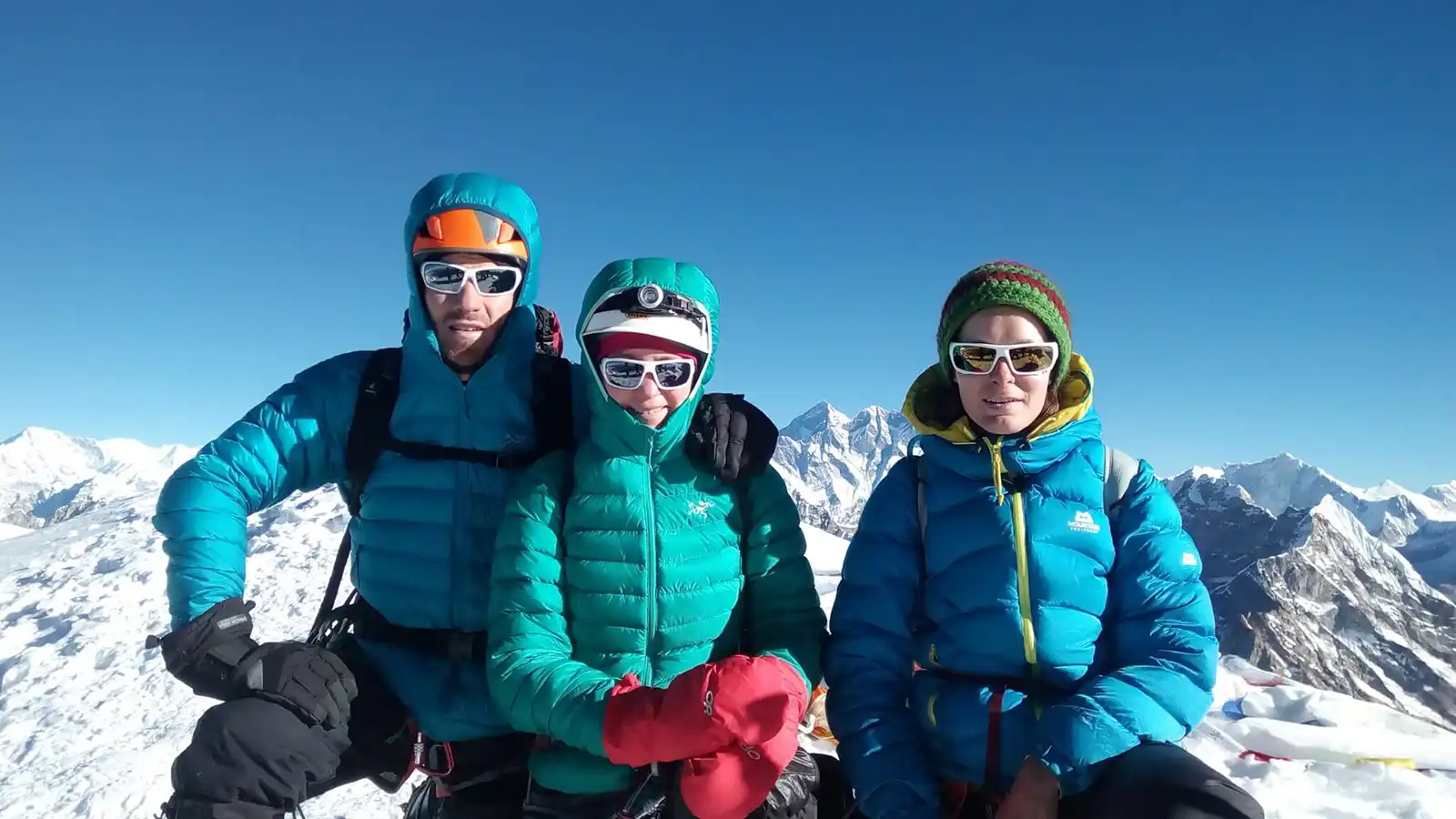
Day 13: Contingency Day
- Extra days are reserved in case of weather delays or unforeseen circumstances.
Day 14: Trek from Chhukung to Pangboche (3,930m)
- Descend through the valley, retracing your steps to Pangboche.
- Visit the Pangboche Monastery, the oldest in the region. Approx. 5–6 hours of trekking.
Day 15: Trek from Pangboche to Namche Bazaar
- Trek back to Namche Bazaar, descending gradually.
- Enjoy the bustling atmosphere of Namche. Approx. 5–6 hours of trekking.
Day 16: Trek from Namche Bazaar to Lukla
- Descend through forests and villages, crossing suspension bridges along the way.
- Celebrate the completion of the trek upon arrival in Lukla. Approx. 6–7 hours of trekking.
Day 17: Fly from Lukla to Kathmandu
- Early morning flight back to Kathmandu.
- Transfer to your hotel and rest your free time exploring the city or shopping for souvenirs.
Day 18: Leisure Day in Kathmandu
- Optional sightseeing, relaxation, or additional days are available for delays in the itinerary.
- Join a farewell dinner hosted by the trekking agency.
Day 19: Departure from Kathmandu
- Proceed to Tribhuvan International Airport for your connecting flight.
- Depart with memories of an unforgettable adventure.
Key Points to Note:
- Acclimatization Days: Days 5, 8, and 10 are essential for adapting to the altitude and reducing the risk of altitude sickness.
- Trekking Routes: The itinerary passes through iconic locations such as Namche Bazaar, Tengboche, and Dingboche, offering cultural and natural highlights.
- Altitude Gains: The climb gradually increases in elevation, with significant gains at Chhukung and the Island Peak Base Camp. Proper acclimatization is planned throughout to ensure a safe and successful summit attempt.
Best Time to Climb Island Peak
Choosing the right season is essential for a successful Island Peak Climbing Itinerary. The most recommended times for this climbing activity are spring (March to May) and autumn (September to November). These seasons have a favorable weather pattern for climbing, so the climb is enjoyable, and the likelihood of achieving the summit is very high.
Spring (March to May)
Spring is an excellent time to follow the Island Peak Climbing Itinerary. The climate remains consistent over this period, with moderate temperatures making the trekking and climbing hassle-free. Further, the melting snow opens up the trails; climbers are also treated to the beautiful blue skies, allowing views of fantastic mountain ranges, including Mount Everest, Lhotse, and Makalu. Of course, the trails are even more enjoyable due to the blooming rhododendrons beautifying the environment.
Advantages of Climbing in Spring:
- Capture the storm weather in the most stable circumstances.
- First and foremost, it is a time of pleasant daytime and cool, refreshing, clear nights that enhance the comfort of the trek for the climbers in spring.
- Nepalese Himalayan ranges are visible and photographable.
- The best views are also provided within climbers’ routes, with beautiful and exciting scenery adding to the enjoyment.
Autumn (September to November)
Autumn is another ideal season for the Island Peak Climbing Itinerary. After the heavy rains, the cool, crisp weather comes in, and the breathtaking views of the mountain ranges, especially the Himalayas, are much seen. The temperatures are more comfortable than the spring season, although the weather remains constant with meager chances of rain or snow. Since there are clear blue skies and settled weather, climbers prefer this season for many reasons, but mainly because they get to see the mountains unclad, and there is better handling of the routes.
Advantages of Climbing in Autumn:
- Cool and dry conditions that are inviting for trekking and climbing.
- During autumn, climbers experience warm temperatures and sunny weather most days, perfect for trekking and climbing.
- Climbers enjoy the climbing experience not just from the trails but also from climbing high enough to take stunning pictures of the peaks from all angles during the climb.
- Less crowded trails compared to peak months.
Climbing During Off-Seasons
While spring and autumn are the best seasons for the Island Peak Climbing Itinerary, some climbers attempt this climb during winter (December to February) and monsoon (June to August). However, these seasons come with added difficulties.
- Winter Climbing (December to February): The temperatures drop significantly, making climbing extremely cold, especially at higher altitudes. The weather becomes unpredictable, with frequent snowfalls, making the ascent more dangerous. Only experienced climbers with proper gear and training should consider a winter climb.
- Monsoon Climbing (June to August): The monsoon season brings heavy rainfall, leading to slippery and muddy trails. Landslides and floods can disrupt the trek, and the cloud cover often obstructs views of the peaks. The wet conditions make the climb more strenuous and challenging. This period is only recommended for climbing if you have significant experience and are prepared for such situations.

Altitude and Acclimatization on the Island Peak Climbing Itinerary
The Island Peak Climbing Itinerary takes climbers through a range of altitudes, from the lush valleys at lower elevations to the challenging heights of the Himalayan peaks. Proper acclimatization is essential to ensure safety and increase the chances of a successful summit. Understanding the altitudes at each stage and how acclimatization is planned can help climbers prepare effectively.
Critical Altitudes Along the Route
-
Kathmandu (1,400m/4,593 ft)
The trip begins in Kathmandu, the capital of Nepal. At 1,400 meters, it serves as the base for final preparations and a chance to rest before heading to the higher elevations.
-
Lukla (2,860m/9,383 ft)
After a short flight from Kathmandu, climbers arrive in Lukla. This mountain town marks the starting point of the trek, and here, climbers begin to adjust to higher altitudes.
-
Namche Bazaar (3,440m/11,286 ft)
The trek continues to Namche Bazaar, the central trading hub of the Everest region. The altitude gain becomes more noticeable, so climbers spend extra time here to acclimatize.
-
Tengboche (3,860m/12,664 ft)
At this stage, the altitude climbs further. Tengboche, known for its famous monastery, provides stunning views of Ama Dablam and Everest.
-
Dingboche (4,410m/14,468 ft)
The village of Dingboche is a critical point for acclimatization. Higher altitudes require an extra day to help climbers adjust before reaching even greater heights.
-
Chhukung (4,730m/15,518 ft)
The trek continues from Dingboche to Chhukung. In this small village, climbers start to prepare for the final stages of the climb.
-
Island Peak Base Camp (5,200m/17,060 ft)
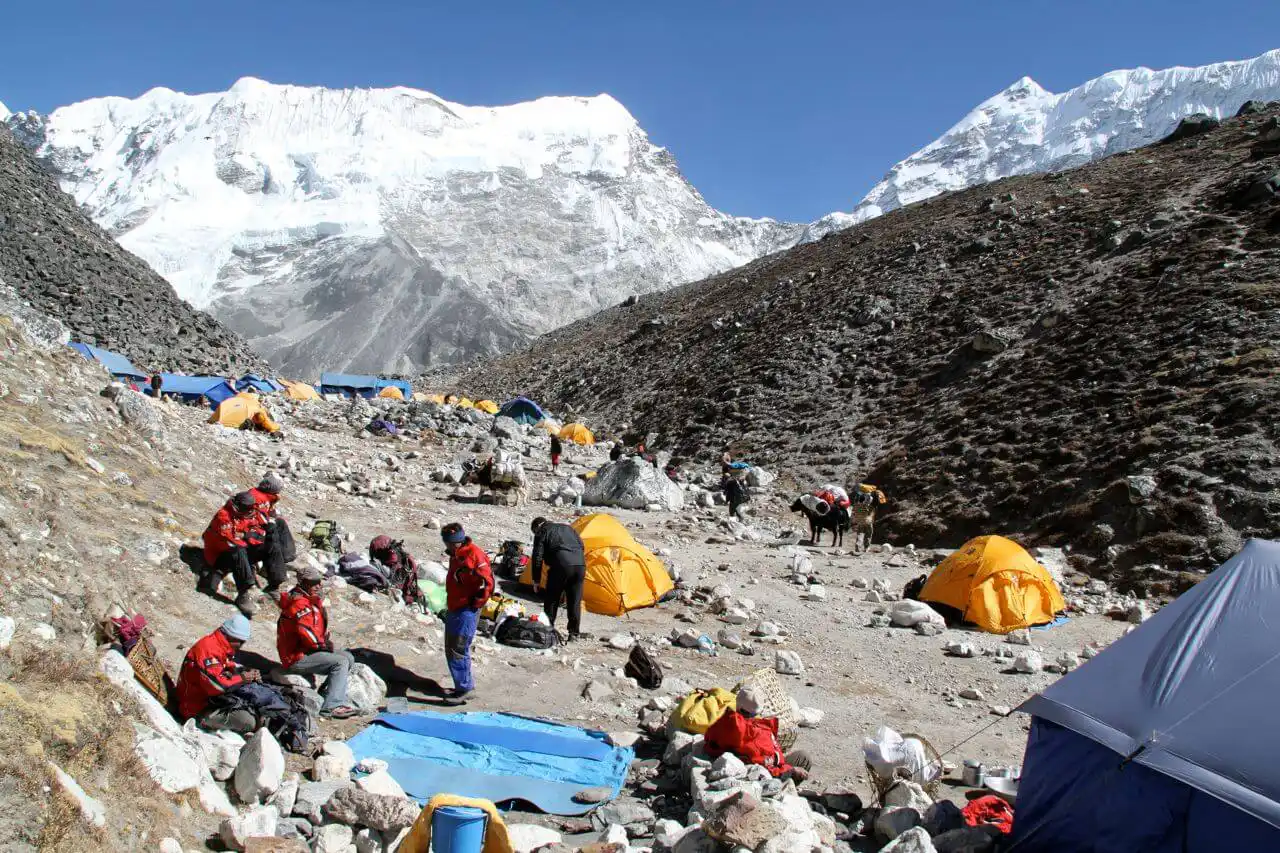
The base camp marks the beginning of the ascent to Island Peak. The high altitude requires careful monitoring of climbers’ physical condition.
-
Island Peak Summit (6,189m/20,305 ft)
The highest point of the Island Peak Climbing Itinerary is the summit, at 6,189 meters. Reaching this altitude requires proper acclimatization and physical endurance as the air becomes thin and breathing becomes more challenging.
Importance of Acclimatization
Acclimatization is the process of allowing the body to adapt to lower oxygen levels at high altitudes. Without proper acclimatization, climbers risk experiencing altitude sickness, which can cause headaches, nausea, dizziness, and, in severe cases, life-threatening conditions. The Island Peak Climbing Itinerary is designed to include acclimatization days to help climbers adjust gradually and safely.
How Acclimatization is Planned in the Itinerary
- Gradual Ascent: The itinerary is structured to avoid rapid altitude gains. Each trekking stage is planned to ensure a steady and gradual increase, allowing climbers’ bodies to adapt to the changing oxygen levels.
- Acclimatization Days: Specific days are set aside for acclimatization. For instance, climbers stay an extra day at Namche Bazaar (3,440m) and Dingboche (4,410m). These days are used for short hikes to higher altitudes before returning to sleep at lower altitudes, a technique that helps the body adjust without overexertion.
- Monitoring Physical Condition: Guides continuously monitor each climber’s health throughout the climb. It ensures that any signs of altitude sickness are detected early. If necessary, climbers can descend to lower altitudes to recover before continuing.
- Hydration and Nutrition: Staying hydrated and maintaining proper nutrition is crucial at high altitudes. The Island Peak Climbing Itinerary emphasizes drinking plenty of water and consuming balanced meals to keep energy levels high and aid in acclimatization.
- Proper Rest: The itinerary allows for adequate rest at each stop, giving climbers time to recover and prepare for the next stage. Rest is essential for physical adaptation and for managing the exertion of climbing.
Fitness and Preparation for the Island Peak Climbing Itinerary
Preparing for the Island Peak Climbing Itinerary requires robust physical fitness and a structured training plan. Success on this climb depends on reaching the summit and ensuring a safe and enjoyable trek through the Himalayas. Understanding the fitness requirements and following a well-designed training regimen is vital to a successful climb.
Physical Fitness Requirements
The Island Peak Climbing Itinerary involves extensive trekking, steep climbs, and technical climbing gear at high altitudes. To cope with the strenuous physical activities one is expected to engage in during the climb, climbers should be in excellent physical condition. Essential fitness requirements include:
- Endurance: The performance of repeated bouts of vigorous or extensive physical activity over some time.
- Strength: This is key for the legs, core, and upper body and is crucial for trekking and climbing.
- Cardiovascular Fitness: Vital for efficient oxygen utilization at high altitudes.
- Flexibility: Helps in preventing injuries during the rigorous climb.
Training Tips for the Island Peak Climbing Itinerary
Start your training at least six months in advance to build the necessary strength and stamina. Here’s a comprehensive approach to structuring your training regimen:
-
Cardiovascular Training
- Goal: Enhance aerobic capacity to optimize oxygen supply to the working muscle.
- Methods: Perform running, cycling, swimming, and fast-paced hiking as activities aimed at the goal. Only perform 4-5 sessions in a week of 30-60.
- Progression: The intensity and duration are increased stepwise to develop endurance.
-
Strength Training
- Objective: Improve muscle power to cope with the demands of climbing and carrying a backpack on the trail.
- Activities: Focus on compound exercises like squats, deadlifts, pull-ups, and planks. Integrate climbing-specific movements.
- Frequency: Conduct strength training 3-4 times per week, focusing on both upper and lower body.
-
Altitude Training
- Goal: Get your body used to high and low oxygen altitudes.
- Methods: If available, practice high-altitude hikes or wear a training mask. Mountain ranges can also serve this method.
- Simulated Altitude: Use of hypoxic training rooms in gymnasiums with altitude simulation facilities.
-
Flexibility and Balance Training
- Goal: Enhance flexibility and balance for effective movement on uneven surfaces.
- Activities: Yoga or Pilate’s exercises are to be included. Pay attention to hip, knee, and ankle mobilization.
- Routine: Stretch daily and do 2-3 yoga or pilates classes weekly.
-
Mental Preparation
- Objective: Be ready mentally for high-altitude climbing challenges.
- Techniques: Use meditation and visualization techniques where you picture yourself completing your climb and think of scenarios where you do not.
-
Practice Hikes
- Objective: Apply your fitness in conditions that mimic those on the Island Peak Climbing Itinerary.
- Implementation: Undertake practice hikes in various terrains. Carry a backpack that mirrors the weight you’ll handle on the actual climb.
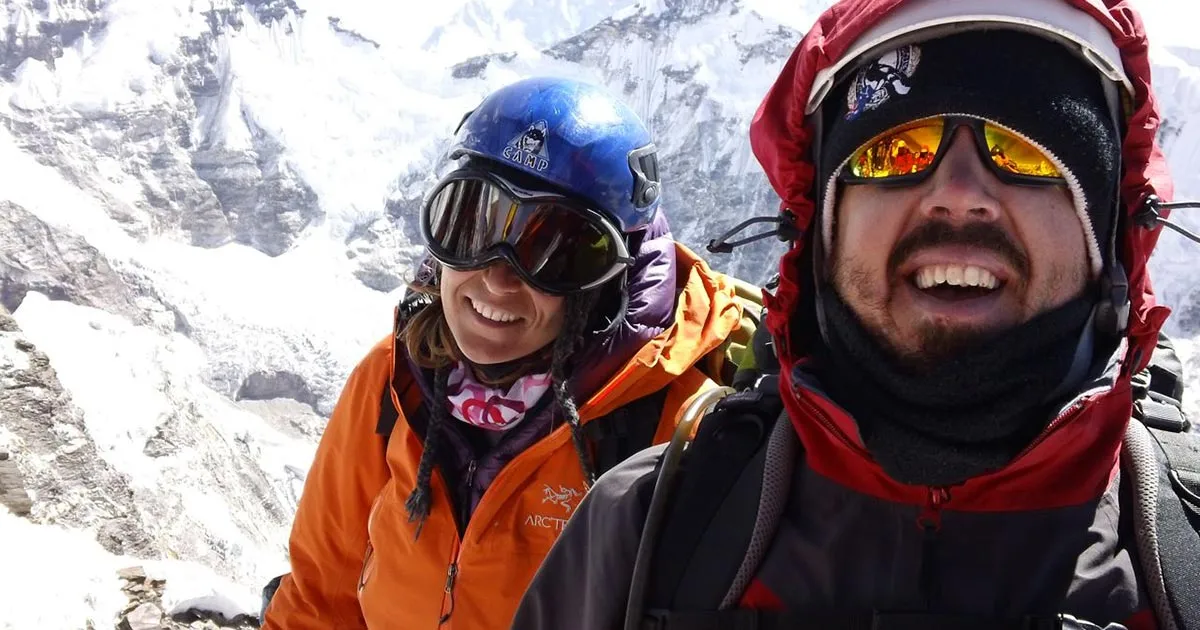
Permits and Regulations for the Island Peak Climbing Itinerary
Obtaining the necessary permits is crucial before beginning the Island Peak Climbing Itinerary. These permits ensure legal access to restricted areas and contribute to the region’s preservation. Understanding the required permits and how to obtain them will help make your climbing experience with Peregrine Treks and Tours smooth and hassle-free.
Types of Permits Required
-
Island Peak Climbing Permit
- Necessity: Anyone planning the Island Peak Climbing Itinerary must secure this permit.
- Purpose: It regulates climbing activities, ensuring safety and environmental conservation.
- Cost: The fee varies by season: USD 250 in spring, USD 125 in autumn, and USD 70 in winter and summer.
-
Sagarmatha National Park Entry Permit
- Necessity: To enter Sagarmatha National Park, part of the Island Peak Climbing Itinerary.
- Purpose: Funds collected through this permit contribute to the park’s conservation efforts.
- Cost: Approximately USD 30 for international climbers and USD 15 for SAARC nationals.
-
Local Area Permit (Khumbu Pasang Lhamu Rural Municipality Permit)
- Necessity: Mandatory for trekking in the Khumbu region, including sections of the Island Peak Climbing Itinerary.
- Purpose: Supports local infrastructure and management of tourist flow.
- Cost: Around USD 20.
Where and How to Obtain the Permits
-
Island Peak Climbing Permit
- Where to Obtain: Such permits are in the custody of the Nepal Mountaineering Association (NMA) in Kathmandu.
- How to Obtain: Climbers can apply for the climbing permit at the NMA office or through Peregrine Treks and Tours, which offers more straightforward and faster services. Some of the requirements include a photocopy of the applicant’s passport, current photographs, and a document giving the details of the climbing route to be followed.
-
Sagarmatha National Park Entry Permit
- Where to Obtain: It is available at the Nepal Tourism Board Office in Kathmandu or the park entrance at Monjo.
- How to Obtain: You can apply in person or let Peregrine Treks and Tours handle this as part of the Island Peak Climbing Itinerary package.
-
Local Area Permit
- Where to Obtain: Issued at Lukla upon arrival or arranged by your trekking agency.
- How to Obtain: Present your identification and pay the fee. Peregrine Treks and Tours typically include this permit in the comprehensive Island Peak Climbing Itinerary.
Essential Tips for Managing Permits
- Use a Reputable Trekking Agency: Peregrine Treks and Tours’ services ease permit processing. They handle all the paperwork and ensure the local regulations are followed.
- Plan: It is a good idea to secure your permits before the trek starts, especially during the busy climbing periods, to prevent unnecessary scenarios at the eleventh hour.
- Carry Copies of Permits: Always ensure you have your permits while on the trek. It will be beneficial when checking at certain places along the Island Peak Climbing Itinerary.
Safety and Guides for the Island Peak Climbing Itinerary
Safety is a top priority when planning your Island Peak Climbing Itinerary. Hiring experienced guides and porters ensures a safe and enjoyable climb. Opting for a trustworthy travel agency can also greatly enhance your experience.
Importance of Hiring Experienced Guides and Porters
Knowledge of the Terrain
- Skilled guides understand the Island Peak Climbing Itinerary’s specific routes, climatic conditions, and elevation variations. Thus, their expertise saves climbers from difficulties associated with the environment.
- Guides can adapt to changing conditions, suggesting alternative routes when necessary.
Safety and Emergency Response
- Instructors are certified in first aid and manage altitude sickness. They develop and act on symptoms, which is very important at a high altitude.
- Porters help carry equipment, reducing climbers’ physical strain and allowing them to focus on acclimatizing and enjoying the trek.
Local Expertise and Cultural Insights
- Guides offer insights into the local culture, adding a richer dimension to the Island Peak Climbing Itinerary. Their connections with local communities can also enhance your experience.
- Porters, often from the local Sherpa community, are well-acquainted with the region and contribute to the trek’s overall safety and smooth progression.
Tips on Choosing a Reliable Tour Operator
Check Credentials
- Ensure the operator is licensed and affiliated with reputable organizations like the Nepal Mountaineering Association (NMA). It ensures that guides are certified and trained in safety protocols.
Read Reviews and Testimonials
- Look for feedback from previous climbers following the Island Peak Climbing Itinerary with the operator. Honest reviews can provide insights into the company’s professionalism, reliability, and safety measures.
Inquire About Safety Standards
- Ask about the safety equipment provided, emergency procedures, and the guide-to-client ratio. A good tour operator will prioritize safety and transparency.
Assess Experience and Local Knowledge
- Select a business that has been organizing climbs in the Everest region for an extended period. Such experience is essential, especially in high-altitude practices like trekking, where climate and weather change quickly.
What to Expect During the Island Peak Climb
The Island Peak Climbing Itinerary combines trekking through scenic landscapes with a challenging ascent to the summit. Here’s what climbers can expect:
Trekking and Climbing Experience
Terrain
- The trek begins on well-kept tracks in lush green valleys and associated scenic villages like Namche and Dingboche Bosom. As the climbers rise, the elevations become rough and semi-rocky surfaces, especially nearing the Island Peak Base Camp.
- The ascent’s last stage involves climbing steep snow slopes and jigsawing through glacial parts with fixed ropes. Basic mountaineering skills are all required, and the guides will help you learn how to use them effectively.
Weather
- Weather conditions can vary greatly. Spring (March-May) and autumn (September-November) are the best times to follow the Island Peak Climbing Itinerary, with stable weather and clear skies. However, temperatures drop significantly at higher altitudes, especially at night.
- Be prepared for sudden changes, including snowfall and high winds. Proper gear is essential to manage these conditions.
Challenges
- High altitudes provide an unavoidable challenge. Climbers have to undergo the acclimatization process sensitively so that they do not experience altitude sickness. Climb with Me is built with rest days for acclimatization as part of the plan.
- Getting the last bit of height to the peak is more tasking and requires special climbing gear. The guides will demonstrate how to use ropes, climb with crampons, and cross glaciers safely.
Accommodation and Food Options
Tea Houses
- Throughout the trekking route, climbers will stay in traditional tea houses. These lodges offer basic but comfortable accommodations, including shared rooms and communal dining areas.
- Tea houses provide a warm place to rest, rehydrate, and enjoy local cuisine. Most will have basic amenities like charging stations and limited Wi-Fi.
Camps at Higher Altitudes
- As you approach Island Peak Base Camp, accommodations shift to tented camps. Your trekking team sets up the camps, which include sleeping tents, dining tents, and kitchen tents.
- Although more basic than tea houses, the camps offer a memorable experience under the starry Himalayan sky, with the towering peaks surrounding you.
Food Options
- Along the Island Peak Climbing Itinerary, climbers can enjoy local Nepalese dishes and Western meals. Tea houses serve popular items like dal bhat (rice and lentils), noodles, soups, and pancakes.
- During the camping phase, cooks prepare nutritious meals to keep energy levels high. Drink plenty of water to stay hydrated, especially at higher altitudes.
Conclusion
Preparing for the Island Peak Climbing Itinerary involves more than just physical fitness. Mental preparedness, adequate equipment, correct food intake, and knowledge about altitude sickness are all significant factors that guarantee safety and successful completion of the climb. After proper training, correct packing, and acclimatization, mountains such as Island Peak can be climbed without fear.
Island Peak is a perfect highway for climbers who wish to ascend more technical peaks, such as Ama Dablam and Mount Everest. Trekking and mountaineering allow first-timers who want to push their limits to enjoy the climb or experienced climbers who want to prepare for higher peaks. All these aspects are considered, and Island Peak presents a challenging climb and an opportunity to marvel at the spectacular view of the Himalayas.
